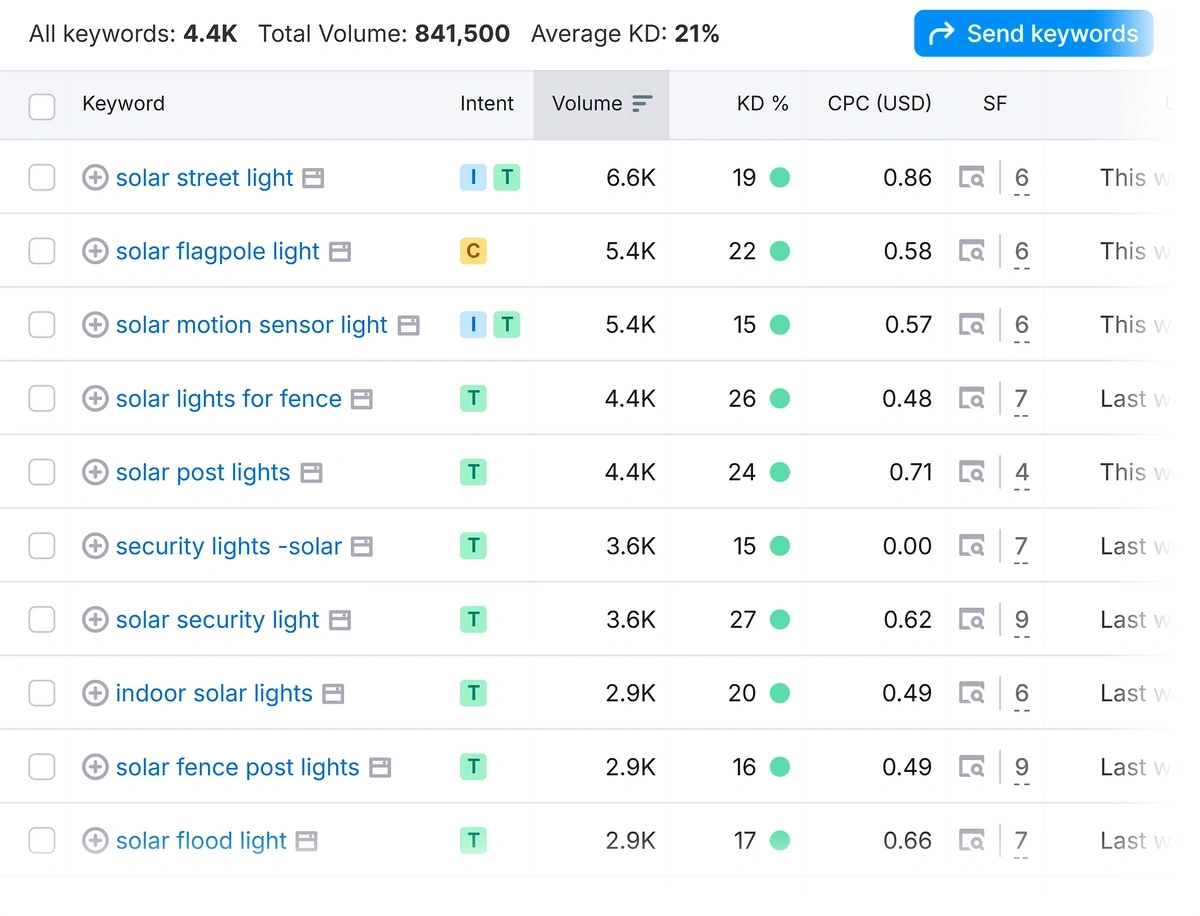
How to Find Keywords With High Search Volume for SEO & PPC
Want to use SEO to drive qualified traffic and increase sales?
Keywords with high search volume will increase your organic traffic.
However, it’s important to consider search volume in tandem with other metrics.
This tutorial walks you through the selection process I use to outrank competitors.
What Is Keyword Search Volume?
Keyword search volume estimates how many times users will use a specific search query each month in Google, or a similar search engine.
You can filter this data by country, region, and city.
Knowing the search volume is important when building your SEO strategy. You’ll want to target terms that are relevant to your target audience, while also bringing in a healthy number of visitors from organic search.
If you’d like to try a quick search volume check, you can find keyword search volume data using our free keyword research tool.
I’m going to show you how to conduct keyword research in Semrush, which offers more detailed metrics.
Enter a keyword into the Semrush Keyword Overview tool, and you’ll see the estimated monthly search volume.
In the example below, we entered “spacex launch.” The estimated U.S. volume, displayed at top left, is over 165k.
Why is search volume important for SEO or PPC? This metric enables you to:
- Assess interest: Checking search volume will prevent you from chasing topics that yield little traffic.
- Prioritize keywords: Search volume is helpful when deciding between similar keywords.
- Increase sales: Targeting keywords that signal buying intent, are easy to rank for, and have high volume, delivers results.
- Control PPC costs: The higher the search volume, the higher the CPC (cost-per-click) may be.
Tip: Base each article you create on a keyword strategically chosen to deliver something of value to your business.
Different software platforms differ in how they estimate search volume. For this reason, some marketers consult more than one source of search volume data to make their decisions.
Get More Search Traffic
Use trending keywords to create content your audience craves.
How Search Volume Is Calculated
Search volume is calculated with proprietary algorithms and third-party information, like clickstream data.
Search volume formulas vary across SEO tools like Semrush, Ahrefs, and Google Keyword Planner. Not surprisingly, the estimates vary as well.
For instance, Google Keyword Planner (GKP) will display Google search volume for a single keyword. However, when it does so, it incorporates data for synonyms and related keywords. So don’t be surprised if its estimates are higher than those you’d find elsewhere.
Meanwhile, it’s common for each keyword research tool to claim it has the most accurate data.
- Ahrefs reports that it “ungroups” these GKP word clusters for more accurate data.
- And Semrush says it has the most accurate search volume data.
We've put together a comparison of Google Keyword Planners vs Ahrefs. Keep in mind that several factors influence estimated search volume, including:
- Seasonal trends
- Competition for the keyword
- Keyword difficulty and intent
What’s Considered ‘High’ Search Volume?
While search volume data is often used to get an idea of potential traffic for a specific keyword, it’s best to consider the data relative.
How to apply it: Once you’ve followed the process described below and finalized your keyword choices, opt for those with the highest search volume.
Low-volume vs. trending keywords: Keep in mind that low-volume keywords can be on the cusp of exponential growth. Burgeoning interest in a product, company, or activity often generates trending keywords.
Entrepreneurs and investors use Exploding Topics Pro to identify these trending keywords. Combined with other factors, trending keywords can be used to make prescient decisions in acquisitions, investments, and marketing.
How to Find Keywords with High Search Volume
The process below will show you how to find valuable and relevant keywords with relatively high search volume.
1. Start with a Seed Keyword
A seed keyword is the main topic you’re researching.
Say you own an online store selling eco-friendly products.
You’re getting ready to launch a new line of solar lighting. You plan to publish a series of blog posts about solar lighting products to attract a qualified audience.
You’re also looking for ideas for new solar lighting products to carry.
Here are two ways to come up with seed keywords.
Start With Exploding Topics Pro
Add a broad term like “solar lighting” into Exploding Topics, and you’ll discover trending keywords. These are keywords experiencing explosive growth.
You’ll find plenty of trending products like the one below.
For each trending topic, you’ll see forecasted growth. Select up to a 5-year time frame.
As a store owner, you could find a few trending products you’re interested in and analyze them in Semrush.
Or Start in Semrush
Conversely, you can brainstorm broad topics and add them directly to the Semrush Keyword Overview.
Here’s how to start analyzing your seed keyword.
- In Semrush, click Keyword Overview in the left-hand navigation column.
- Enter “solar lighting” in the field at the top and click the orange search button.
We see that:
- U.S. search volume for this term is 6.6k/month
- Global volume is 119.2k/month
Notice the American flag icon? Semrush detects my country automatically.
To the right, you’ll see Global Volume. Global Volume is the volume of searches by keyword for all countries.
Use the dropdown menu at the top-left of the Keyword Overview to get country-specific data.
Click the Select Location dropdown to get city, municipality, and regional data.
Next to volume, you’ll also see a Keyword Difficulty score and an Intent label.
You want to filter for Keyword Difficulty and Intent before you choose your final keywords.
In the next step, you’ll learn how to do this.
Tip: Enter your domain name into the Keyword Overview for personalized data, such as Keyword Difficulty scores based on your website.
2. Check Keyword Difficulty and Intent
In the Semrush Keyword Overview tool, our seed keyword “solar lighting” has a Keyword Difficulty label of “Possible” and a KD% score of 37%.
Keyword Difficulty measures how hard it is to rank in the top 10 Google search results for a given keyword.
You can do a quick check on any keyword with a keyword difficulty checker.
Some keywords are easy to rank for, while others are nearly impossible. That’s why it’s crucial to check this metric. Otherwise, you could waste resources chasing the wrong keywords.
In Semrush, you’ll find Keyword Difficulty displayed:
- By descriptive label (like “Easy” or “Very easy”)
- By numerical score (KD%). (The higher the number, the harder the keyword is to rank for.)
Here are the Keyword Difficulty labels Semrush uses, along with their explanation and corresponding numerical score (KD%).
| Keyword Difficulty label | Semrush Explanation | KD% |
| Very easy | Your chance to start ranking new pages on Google as soon as possible without any backlinks. | 0-14 |
| Easy | It is quite possible to rank for this keyword. You will need quality content focused on the keyword’s intent. | 15-29 |
| Possible | A competitive keyword to rank for. You will need well-structured and unique content. | 30-49 |
| Difficult | You will need to have 82 referring domains and optimized content to compete here. | 50-69 |
| Hard | This keyword will demand 158 high-authority referring domains and well-optimized content to start ranking for it. | 70-84 |
| Very hard | The hardest keyword to compete for. It will take a lot of on-page SEO, link building, and content promotion efforts. | 85-100 |
If your online store is new, or you aren’t ranking in the top 10 of Google for keywords you previously targeted, stick with “Easy” or “Very easy” keywords.
This advice goes for content marketers as well. Don’t let a client with a new or underperforming site persuade you to target a hard keyword.
Once your site ranks near the top of Google for multiple keywords (something you can easily check with our Website Rank Tracker), it will gain authority and backlinks. This will position you to try keywords at the next difficulty level: “Possible.”
Since our seed keyword is rated “Possible” instead of “Easy” or “Very easy,” what can we do?
Click on the Keyword Magic tool in the left-hand navigation.
This will generate a list of related keywords with varying difficulty levels and search volume estimates.
Next, apply 2 filters to our list.
- Use the KD% dropdown and select “Easy” or “Very easy.”
- Then click the Intent dropdown and tick both the Commercial and Transactional boxes.
Now, we have a useful list of easy keywords that signal buying intent.
These keywords are conveniently listed in descending order of search volume.
Now, you can choose keywords that fit your purpose and have the highest search volume.
Here are some examples for our fictitious online store.
| Keyword | Keyword Difficulty | Search Volume | Search Intent |
| Solar fence lights | Easy | 8,100 | T - Transactional |
| Solar flagpole light | Easy | 6,600 | C - Commercial |
| Solar landscape lighting | Easy | 6,600 | T - Transactional |
| Solar powered string lights | Easy | 6,600 | T - Transactional |
In my experience, this process is one of the most powerful ways for a site to gain traction and deliver on top-line business objectives.
3. Review Competitive Density and Cost Per Click
If you’re researching search volume for PPC campaigns, reviewing the Competitive Density and Cost-per-Click (CPC) metrics is crucial.
Once you’ve got a set of keywords you’re considering, compare these two metrics. But keep search volume in mind.
You can sort by Competitive Density and CPC ranges using the filters at the top.
Remember, our example list is already filtered to display only Commercial or Transactional Intent keywords. And we filtered it for keywords that are easy to rank for.
With this data, you can also decide whether it’s more cost-effective to run an ad campaign or to create content on the selected keyword(s).
Final Tips
I’ve used Semrush for many client projects and have a few pro tips to share:
- Not only can you run ad campaigns and create blog posts based on high search volume keywords, but you can also add them to landing pages
- Remember to use the Semrush Position Tracking tool to create keyword lists; it helps you to monitor how your high search volume keywords perform
- Long-tail keywords may not have high search volume, but they can convert well because they are super targeted
Start Finding Keywords With High Search Volume
Ready to stop guessing and start maximizing growth?
You now have a proven keyword research method to:
- Identify high volume keywords that drive qualified traffic.
- Pinpoint search terms with maximum revenue potential.
- Outmaneuver competitors by targeting strategic, low-competition keywords.
- Transform your SEO and PPC campaigns with data-driven insights.
Semrush makes it easy to find keywords with high search volume that are easy to rank for. It shows more metrics than many other keyword research tools, so all the data you need is at your fingertips.
Sign up for a free Semrush trial and start finding powerful keywords today.
Stop Guessing, Start Growing 🚀
Use real-time topic data to create content that resonates and brings results.
Exploding Topics is owned by Semrush. Our mission is to provide accurate data and expert insights on emerging trends. Unless otherwise noted, this page’s content was written by either an employee or a paid contractor of Semrush Inc.
Share
Newsletter Signup
By clicking “Subscribe” you agree to Semrush Privacy Policy and consent to Semrush using your contact data for newsletter purposes
Written By


Sherrie Gossett has a knack for uncovering hidden trends and opportunities that others overlook, drawing on her extensive experien... Read more











